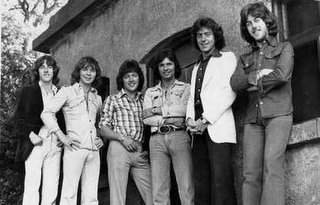Asbos, Asbestos ...And the band
 MIAMI SHOWBAND,
MIAMI SHOWBAND,Summer 1975.
Left to right Tony Geraghty (killed) Fran O'Toole (killed), Ray Millar, Des Lee (managed to flee across field), Brian McCoy(killed) and Steve Travers (wounded but survived).
FROM time to time, historians following up interesting trails behind the scenes of 20th century history have been frustrated to hear that what might be important source documents were "destroyed in a fire during the Blitz".
Now, as the Second World War slowly recedes into the past, and ideas like glasnost or "freedom of information" have promised new expanding horizons for exploration, other obstacles may arise. Like, instead of "destroyed by the Luftwaffe", "contaminated by asbestos". (For non-British readers I should explain that I could not resist reference in my title to another piece of New Labour ingenuity, Anti-Social Behaviour Orders, hence Asbos, a new word in the dictionary. Supposed to deal with noisy neighbours and obnoxious hooligans, but already used to stop an old lady in Yorkshire protesting at Menwith Hill US spy base)
A report in the Guardian on Wednesday December 28, said thousands of sensitive secret documents are being held back from publication under the Freedom of Information Act on the grounds that they may be contaminated by asbestos. Ministry of Defence officials say the documents were stored in an area of the old War Office building in Whitehall where asbestos was discovered a number of years ago.
"Dozens of requests for information made under the FoI have already been turned down by the ministry, and a number of documents dating back to 1975, which were due for automatic release under the 30-year rule, are also being held back".
"Officials say that the contents of each file will eventually be considered for release once it has been decontaminated and copied. That process is unlikely to be completed before summer of 2007 at the earliest. Some 63,000 files, containing around 10m pages, are affected. The MoD has turned down 27 requests for information, concerning 288 files, which were made under the act".
The Guardian has seen the titles of some of these files, and the list makes interesting reading. "One is entitled Sale of Arms to Saudi Arabia. Another is Production of Chemical Weapons, while a third is Medical Aspects of Interrogation. Several files about SAS operations in Borneo are being withheld, as are others about the financing of GCHQ, the government's eavesdropping organisation.
There are also a number of files with intriguing titles such as Operation Tiara, Operation Grape, and Project R1, as well as some which contain details of supposed UFO sightings. One batch of papers concerns a detention centre in Kensington, west London, known as the London Cage, where German prisoners of war were tortured during and after the second world war.
Officials deny the documents were being withheld in order to delay the publication of their contents. "We have had to take these steps under health and safety law," a spokesman said. "Once the area was discovered to be contaminated the documents that were held there were considered to be contaminated. We have since found traces of asbestos on some of the documents."
Each document was being carefully copied, he said, and the originals would be retained if they were considered to have value.
Among the papers which were due to be released under the 30-year rule are thought to be some concerning the Miami Showband killing. In July 1975 this highly popular Irish band were returning from a gig in Belfast when their minibus was stopped, near Newry, at what they took to be an army checkpoint.
The Miami Showband had expressed a hope that their music could unite communities. But July 31 was to be the day the music stopped for northern Ireland.
While they were detained at the roadside, two men tried to plant a bomb in the back of the van but were killed when it went off. Then three of the band members were shot dead. It looked like the bomb had been intended both to kill the whole band and make it look as if they were themselves "IRA terrorists" who had been killed while carrying the device. Having botched it, the killers gunned the musicians down by the roadside. But one man survived after being shot, and another had managed to run across fields.(another member was travelling ahead with their equipment).
In 1976, two men from the Ulster Defence Regiment were jailed for 35 years for the killing. They were members of the Ulster Volunteer Force (UVF), which was officially outlawed after the band killing. But survivors of the ambush said the man leading the murder gang spoke with an English accent and wore British Army uniform.
They are angry about the delay in publishing documents, as they still want to know who was behind the attack. So do others. It has been claimed that the gang involved were also linked with the bombings in Dublin and Monaghan, and that British officer Captain Robert Nairac, later killed by the IRA was their link with the British forces. Whatever the exact facts, the attack on the band, together with the bombings, helped end a series of IRA cease-fires and tentative peace negotiations with which 1975 had begun.

0 Comments:
Post a Comment
<< Home